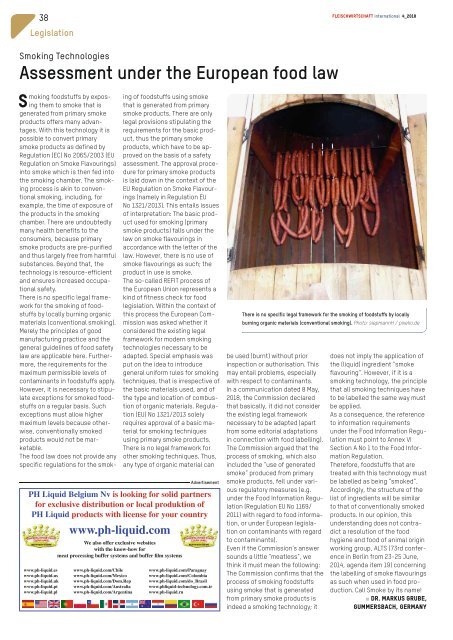FLEISCHWIRTSCHAFT international_04_2018
- No tags were found...
You also want an ePaper? Increase the reach of your titles
YUMPU automatically turns print PDFs into web optimized ePapers that Google loves.
38<br />
Fleischwirtschaft <strong>international</strong> 4_<strong>2018</strong><br />
Legislation<br />
Smoking Technologies<br />
Assessment under the European food law<br />
Smoking foodstuffs by exposing<br />
them to smoke that is<br />
generated from primary smoke<br />
products offers many advantages.<br />
With this technology it is<br />
possible to convert primary<br />
smoke products as defined by<br />
Regulation (EC) No 2065/2003 (EU<br />
Regulation on Smoke Flavourings)<br />
into smoke which is then fed into<br />
the smoking chamber. The smoking<br />
process is akin to conventional<br />
smoking, including, for<br />
example, the time of exposure of<br />
the products in the smoking<br />
chamber. There are undoubtedly<br />
many health benefits to the<br />
consumers, because primary<br />
smoke products are pre-purified<br />
and thus largely free from harmful<br />
substances. Beyond that, the<br />
technology is resource-efficient<br />
and ensures increased occupational<br />
safety.<br />
There is no specific legal framework<br />
for the smoking of foodstuffs<br />
by locally burning organic<br />
materials (conventional smoking).<br />
Merely the principles of good<br />
manufacturing practice and the<br />
general guidelines of food safety<br />
law are applicable here. Furthermore,<br />
the requirements for the<br />
maximum permissible levels of<br />
contaminants in foodstuffs apply.<br />
However, it is necessary to stipulate<br />
exceptions for smoked foodstuffs<br />
on a regular basis. Such<br />
exceptions must allow higher<br />
maximum levels because otherwise,<br />
conventionally smoked<br />
products would not be marketable.<br />
The food law does not provide any<br />
specific regulations for the smoking<br />
of foodstuffs using smoke<br />
that is generated from primary<br />
smoke products. There are only<br />
legal provisions stipulating the<br />
requirements for the basic product,<br />
thus the primary smoke<br />
products, which have to be approved<br />
on the basis of a safety<br />
assessment. The approval procedure<br />
for primary smoke products<br />
is laid down in the context of the<br />
EU Regulation on Smoke Flavourings<br />
(namely in Regulation EU<br />
No 1321/2013). This entails issues<br />
of interpretation: The basic product<br />
used for smoking (primary<br />
smoke products) falls under the<br />
law on smoke flavourings in<br />
accordance with the letter of the<br />
law. However, there is no use of<br />
smoke flavourings as such; the<br />
product in use is smoke.<br />
The so-called REFIT process of<br />
the European Union represents a<br />
kind of fitness check for food<br />
legislation. Within the context of<br />
this process the European Commission<br />
was asked whether it<br />
considered the existing legal<br />
framework for modern smoking<br />
technologies necessary to be<br />
adapted. Special emphasis was<br />
put on the idea to introduce<br />
general uniform rules for smoking<br />
techniques, that is irrespective of<br />
the basic materials used, and of<br />
the type and location of combustion<br />
of organic materials. Regulation<br />
(EU) No 1321/2013 solely<br />
requires approval of a basic material<br />
for smoking techniques<br />
using primary smoke products.<br />
There is no legal framework for<br />
other smoking techniques. Thus,<br />
any type of organic material can<br />
Advertisement<br />
There is no specific legal framework for the smoking of foodstuffs by locally<br />
burning organic materials (conventional smoking). Photo: siepmannH / pixelio.de<br />
be used (burnt) without prior<br />
inspection or authorisation. This<br />
may entail problems, especially<br />
with respect to contaminants.<br />
In a communication dated 8 May,<br />
<strong>2018</strong>, the Commission declared<br />
that basically, it did not consider<br />
the existing legal framework<br />
necessary to be adapted (apart<br />
from some editorial adaptations<br />
in connection with food labelling).<br />
The Commission argued that the<br />
process of smoking, which also<br />
included the “use of generated<br />
smoke” produced from primary<br />
smoke products, fell under various<br />
regulatory measures (e.g.<br />
under the Food Information Regulation<br />
(Regulation EU No 1169/<br />
2011) with regard to food information,<br />
or under European legislation<br />
on contaminants with regard<br />
to contaminants).<br />
Even if the Commission’s answer<br />
sounds a little "meatless", we<br />
think it must mean the following:<br />
The Commission confirms that the<br />
process of smoking foodstuffs<br />
using smoke that is generated<br />
from primary smoke products is<br />
indeed a smoking technology; it<br />
does not imply the application of<br />
the (liquid) ingredient “smoke<br />
flavouring”. However, if it is a<br />
smoking technology, the principle<br />
that all smoking techniques have<br />
to be labelled the same way must<br />
be applied.<br />
As a consequence, the reference<br />
to information requirements<br />
under the Food Information Regulation<br />
must point to Annex VI<br />
Section A No 1 to the Food Information<br />
Regulation.<br />
Therefore, foodstuffs that are<br />
treated with this technology must<br />
be labelled as being “smoked”.<br />
Accordingly, the structure of the<br />
list of ingredients will be similar<br />
to that of conventionally smoked<br />
products. In our opinion, this<br />
understanding does not contradict<br />
a resolution of the food<br />
hygiene and food of animal origin<br />
working group, ALTS (73rd conference<br />
in Berlin from 23-25 June,<br />
2014, agenda item 19) concerning<br />
the labelling of smoke flavourings<br />
as such when used in food production.<br />
Call Smoke by its name!<br />
r Dr. Markus Grube,<br />
Gummersbach, Germany

















